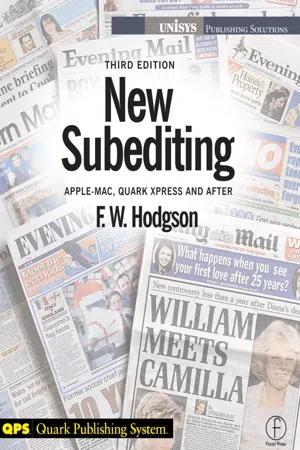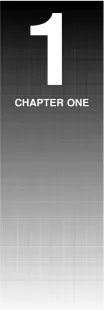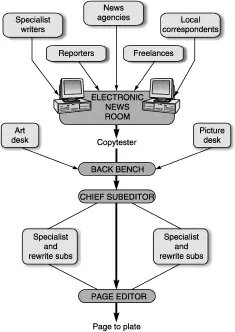![]()
WHAT IS EDITORIAL PRODUCTION
Editorial production on a daily paper, morning or evening, begins with the selection of the contents for the day’s issue. This does not mean that the writing part has finished. News will continue to be gathered and written up to the last deadline of the last edition, background features will be prepared and photographs shot, but once decisions begin to be taken about the placing of stories in the pages, that is editorial production.
Central to this process is the paper’s team of subeditors, by whom the various tasks of editing are carried out. A prime mover in this early stage of producing the paper is the senior subeditor who selects and shortlists from the mass of incoming material the stories most likely to be used. Since copy is the name for all the material keyboarded in by the writers, copytasting is the word used for the selecting of this material, and the person who initiates the process is the copytaster.
News creation is a round-the-clock operation into which a newspaper tunes during its hours of production. On an evening paper, where work begins about 8 a.m., the newsroom deals first with overnight stories and follow-ups from the previous day’s news. Because of the time difference, foreign copy will be at first predominantly from America. This is why the early editions of evening papers often carry American-originated material which is later thrown out as the flow of home and European stories picks up with the start of the day’s activity cycle.
As edition succeeds edition, from about midday there is a strengthening of the home news-of-the-day content with running stories being updated between editions into the late afternoon, peak time for the inflow of stories being around 2 to 3 p.m. Afternoon cricket scores replace morning and overnight ones; the lateness of racing results is a guide to the press time of the edition you have bought.
The morning paper cycle begins at about 11 a.m. or midday, with edition press times from about 7 p.m. depending on the distribution areas and where the printing presses are that serve them. National papers, printing in a variety of centres these days, publish earlier for more distant areas. Provincial morning papers with their closer distribution can afford to work until well into the evening before getting their first edition away.
Morning paper newsrooms first of all mop up the news of the day, looking for follow-ups where stories have had a good run in the evenings and on television, and giving more detailed versions of stories the evenings have only nibbled at. They have the benefit of evening events, speeches, meetings, functions and theatres and have more time for set-piece interviewing. Because of the time difference, morning papers are stronger on European news and are first with the day’s events from Australia and the Far East. They also have time for polished detailed background features and situationers which give depth and perspective to their coverage.
By the time the last bit of updating has been done and the last edition (not normally later than 2 a.m.) has gone to press, the flow of home and European stories has subsided and the first stories are coming in from America. The news cycle is ready once more for an 8 a.m. start-up by the evenings.
Creating the news
News – features are dealt with later in this book – arrives in a newspaper office from a variety of sources. Common now to all reporters, feature writers and agencies is the practice of keyboarding copy straight into the office computer, from which stories are recalled on to screens for editing into their page slots.
Agency copy is entered likewise and is automatically routed to the desk whose job it is to read and deal with it. Local references are typecoded to help local paper subscribers and draw the news editor’s attention. There are not many jobs these days being carried out by village correspondents where ballpen, typewriter and telephone are the means of origination.
Staff reporters
Staff reporters are the most useful and controllable source of news and the likeliest source of exclusives; all papers like to have something their rivals haven’t got. Numbers vary from about ten to twenty on a small evening paper to forty or more on a national daily. They work from the newsroom or from branch offices and sometimes independently in districts, and they are controlled and briefed by the news editor (or the chief reporter on smaller papers).
Jobs can vary from a simple telephone inquiry, or personal call resulting from a letter or information received, to complicated jobs involving a team of reporters and sometimes several locations. Some stories might have both local and national, or even foreign ‘ends’ and last all day or several days.
If there is no time to get to the office to keyboard copy into the computer, reporters, using portable workstations, file direct into the system by telephone modems; otherwise their copy is taken over the telephone by copytakers, who keyboard it in for them. Where there are bigger staffs a newspaper might use a number of reporters as an investigative team on long-term news projects under a leader or project editor. This is usually planned into the paper in advance as a special news feature.
Freelances
Freelance reporters are used mainly on specialist assignments or for holiday relief work and are paid for the job or days or weeks worked. They are not tied to a paper except where they have a specific contract covering a job or sequence of shifts. Some specialize in investigative writing which they sell to the highest bidder.
Local correspondents
These are journalists working for a local paper, or as local freelances, who are accredited by retainer fee or some special arrangement to a bigger paper to cover stories in the area. They get lineage (a fee per line) for stories used or ordered. The arrangement usually precludes them working for a rival paper. They cover wanted stories where a staff reporter is not available.
News agencies
National and international news agencies work round the clock to provide a variety of services for newspapers all over the world, collecting material from bureaux and correspondents in cities and countries, checking and editing it and distributing it to subscribers.
Most countries have their own national agencies whose services are used by small and medium-sized papers to fill gaps in coverage, or even provide all but local coverage. Agency stories can be used as check sources and many agencies provide news pictures. The international ones such as Reuters, Associated Press, United Press International and Agence France Press are the prime sources of foreign news for papers who have few, or no, foreign corespondents, and also of newsfilm and sound reporting for television and radio. They feed into national news networks stories affecting a country’s own interests and their nationals abroad. News agency correspondents are often the first to break important foreign stories.
Agencies operate in a similar way to newspapers through staff reporters in main centres with local correspondents, or stringers, filing in from the districts. The subediting, which includes headlining, checking and editionizing for the various services, is carried out at the main offices and serves morning, evening and Sunday papers. Most papers in Britain take the Press Association (national) and Reuters general services and some sport, financial, situationer and other services, depending on their contracts. A rent is paid for each.
Handouts
Handouts arrive in newspaper offices in great numbers from all sorts of organizations, including the Government, and sometimes from celebrities, via press officers, whose aim is to reach the public through the newspaper. They are usually given to reporters to read or to specialists whose field they cover in case they contain something of interest to the readers. Reading them can be a tedious and even boring job, but it can yield important stories over a wide field including, for example, housing statistics, immigration, race problems, technology breakthroughs, new cars and copy for consumer columns.
The newsroom
Though the newsroom is the heart of the gathering side of the business (see Figure 8) it is concerned with production, too, for it is here that decisions are taken that will shape the news content of the paper. And, of course, the keystrokes made by the writers are the keystrokes, subject to editing, that set the paper in type.
The news editor, who runs the newsroom, is one of the busiest executives on the paper. The assessment of a news situation depends at the outset on the news editor’s judgement: what news is to be covered, in what depth, and who is to do the work. Reporters and correspondents are briefed so that copy is filed on time and important aspects of stories not missed. Stories are commissioned from freelances and outside specialists, agency input monitored, work checked to see it is done properly, handouts, correspondence, expenses, travel arrangements, interviewing for jobs and a hundred and one other things dealt with. In this work the news editor is helped by a deputy, usually a couple of assistants and a secretary.
The news editor keeps a check on where the staff are, listens to their calls in, decides when to extend coverage of a story, when to ask for more copy and when to call it a day where a story has ‘fallen down’. The advent of the electronic newsroom helps. News editors now check reporters’ files on screen, send back stories where coverage is not enough or has failed in some way, and route stories to the copy taster and chief sub as they become ready for the pages. There is sometimes a reverse traffic on screen of stories sent back by the chief sub who is not happy with them.
The use of portable workstations by reporters has improved newsroom organization. District offices can be controlled electronically through the newsroom’s keyboards, with stories and messages being routed to and fro.
Village and country correspondents of provincial papers now often have their own portable terminals: Women’s Institutes and flower show results have entered the computer age. Most offices have a number of such terminals in use among part-time contributors, while many with their own PCs link up to the office computer by telephone modem to file copy. It all makes for more effective control of coverage,
By the time the editing and making up of the pages begins, a good deal of the decision-making has already taken place. The material has passed through the newsroom system. Stories have been checked by the news editor and sent to the chief sub. Among them, depending on the facts of a story, the amount of space available and the volume of news about, are the candidates for the day’s pages.
Figure 8 The electronic newsroom shown as the fulcrum of copy flow on a typical national daily. Stories are keyed into the system by the writers, checked by the news editor, sorted by the copytaster, planned and placed by the back bench or chief sub, and called up on screen for subbing and building into the page.
The copytaster
In theory, the editor reads everything that is likely to get into the paper. In practice this is seldom possible, although editors are usually given a copy of all reporters’ stories, or can call them up on their personal screens.
The editor, through informal discussions with executives during the day and through the briefings and debate of the daily planning conference, is familiar with the more important stories that are being covered, and at an early stage has ideas about the thrust and balance of the paper. The likelihood of some big stories is known in advance and their place in the paper can be prepared. There are days, however, when because of other concerns, the editor has little time to focus on the whole news input and has to leave some decisions to his executives. The role of the copytaster who, come what may, reads everything that is written and submitted, is thus an important safeguard.
The copytaster is usually the first production journalist to arrive for duty in the editorial room. Here, at a desk close to the chief sub (Figure 8) and usually just in f...



